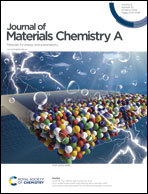Tuning the dimensionality of organic–inorganic hybrid perovskites towards improved photocatalytic hydrogen production†
Abstract
Three-dimensional (3D) and two-dimensional (2D) organic–inorganic hybrid perovskites (OIHPs) have demonstrated attractive potential for producing hydrogen fuel via the photocatalytic pathway. However, the highly dynamic dissolution behaviour of 3D OIHPs in aqueous solution and the inferior light absorption and low charge transfer efficiency of 2D OIHPs represent their respective challenges towards efficient photocatalysis. Herein, we introduce quasi-2D OIHPs, which contain a distribution of grains with dimensionality ranging from 2D to 3D towards alleviating this dilemma. We found that among (CH3(CH2)3NH3)2(CH3NH3)n−1PbnI3n+1 (BA2MAn−1PbnI3n+1, n = 1, 2, 3, ∞) perovskites, the quasi-2D perovskite BA2MAPb2I7 exhibited the highest photocatalytic activity, which is ca. 1.9 times that of the 2D perovskite BA2PbI4 and 23.2 times that of the 3D perovskite MAPbI3. Experimental investigations show that tuning the dimensionality of BA2MAn−1PbnI3n+1 allows simultaneous modulation of the light absorption, charge transport efficiency and dynamic dissolution rate of these perovskites. An optimum balance between these factors was achieved on quasi-2D BA2MAPb2I7, accounting for the highest photocatalytic activity among BA2MAn−1PbnI3n+1. This work demonstrates the potential of dimensional engineering in optimizing the photocatalytic performance of OIHPs.

- This article is part of the themed collection: 2024 Journal of Materials Chemistry A HOT Papers


 Please wait while we load your content...
Please wait while we load your content...